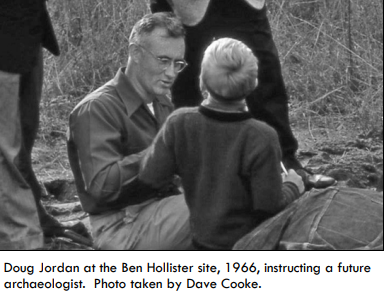
In Remembrance: Douglas F. Jordan
Dr. Douglas F. Jordan, Connecticut's first state archaeologist, died July 29, 2006 after a brief illness.
Doug received his PhD in anthropology from Harvard University and came to Connecticut in 1963 where he
began his teaching career at the University of Connecticut at Storrs. He was appointed State Archaeologist a
short time later.
While participating in field work at the Ben Hollister Site in Glastonbury with the Albert Morgan Chapter
of the Archaeological Society of Connecticut in the mid 1960s he met his wife Barbara.
Many of us remember his dry sense of humor and his exacting emphasis to details when excavating an
archaeological feature. He was a teacher of the first magnitude.
Doug was a loyal member of FOSA and his numerous monetary contributions were always "Anonymous."
Douglas is survived by his daughter Amanda Louise Jordan and son-in-law Eric Weis, niece Lisie Bambas and
nephew Kenneth Richards. He was preceded in death by his wife Barbara M. Jordan.
Doug Jordan will be greatly missed by all his friends and colleagues.
------------------------------------
by Nick Bellantoni, as printed in September, 2006 ASC Newsletter
Douglas F. Jordan received his BA from Dartmouth College in 1949. He later earned his MA and PhD in
anthropology from Harvard University. Prior to his appointment to the University of Connecticut in
1963, he was an archaeologist for the National Park Service, and at the Florida State Museum. At the
University of Connecticut, he accepted a position teaching in the Anthropology Department, and was
also appointed the first State Archaeologist of Connecticut. In addition, he served as Curator of the
university's anthropological collections.
He served for more than two decades as the State Archaeologist, and was the most visible leader
of the professional and amateur archaeologists in the state. He served the Archaeological Society
of Connecticut consecutively as Program Chairman, Newsletter editor, and President. He was also
a longtime member of the Massachusetts Archaeological Society. His work with the amateur community set the
stage for both archaeological societies to develop an important working relationship between professional
and avocational archaeologists in New England. He was responsible for attracting the Norris L. Bull
Collection of pre-Contact and Contact Native American artifacts to UConn.
His intellectual and research interests fell into two distinct categories. The first is the
prehistoric archaeology of eastern North America, and New England in particular. He excavated and
conducted research at the Bull Brook, Schwartz, Woodchuck Knoll and Hollister Sites among many.
His second, but, not lesser, interest was in primitive technology - from
stone tools to ceramics to metallurgy, from watercraft to weapons to cooking vessels.
He was a prominent and active instructor of undergraduates and graduates. He was personally
responsible for the education of an entire generation of archaeologists, many of which are active
professionally in the field today. Doug directed the UConn summer archaeological field school
teaching archaeological techniques and methods for more than a quarter of a century.
------------------------------------
Readers are invited to add their thoughts.
Please send an email to fosa.ct@gmail.com, using "FOSA Website: Remembrance" in the subject line.